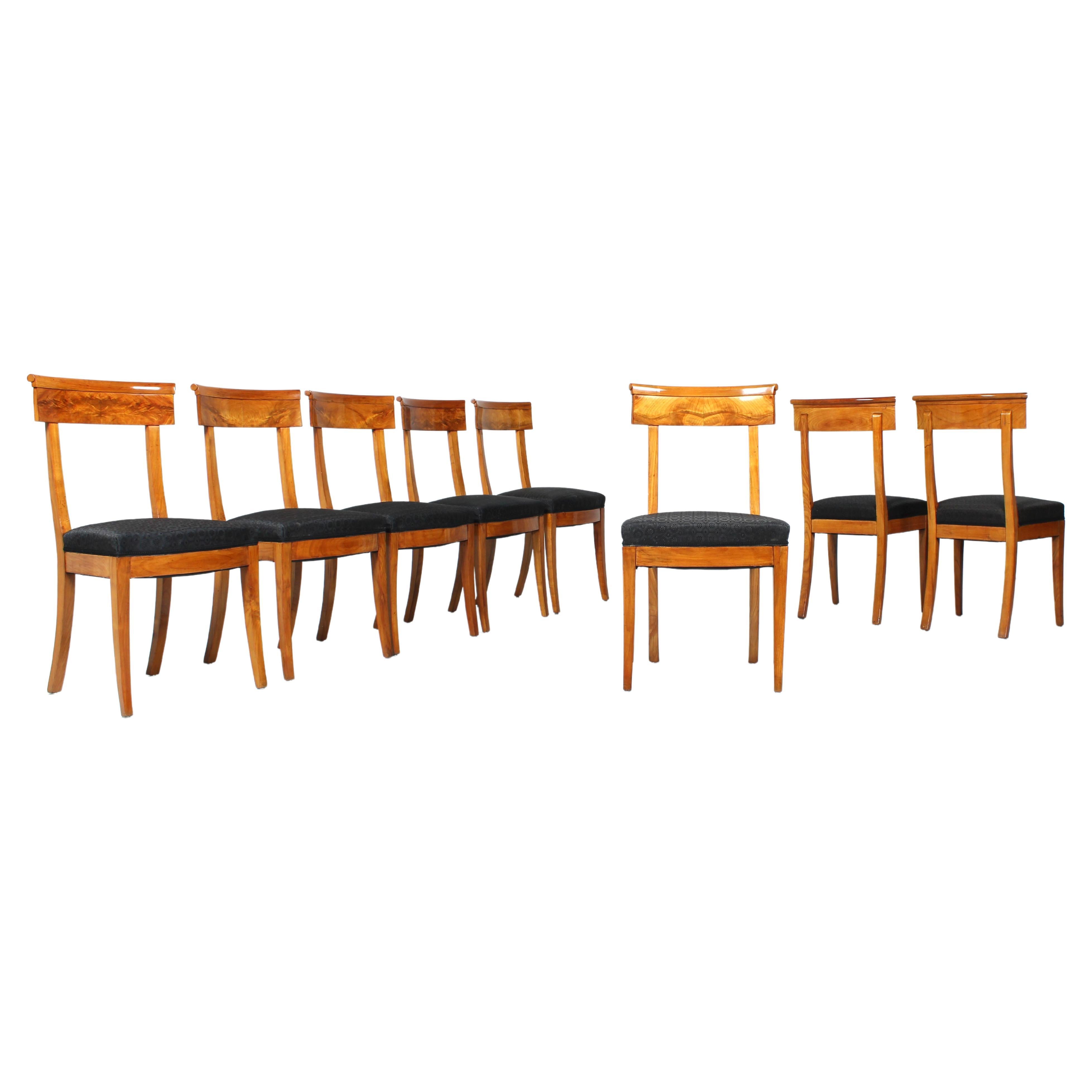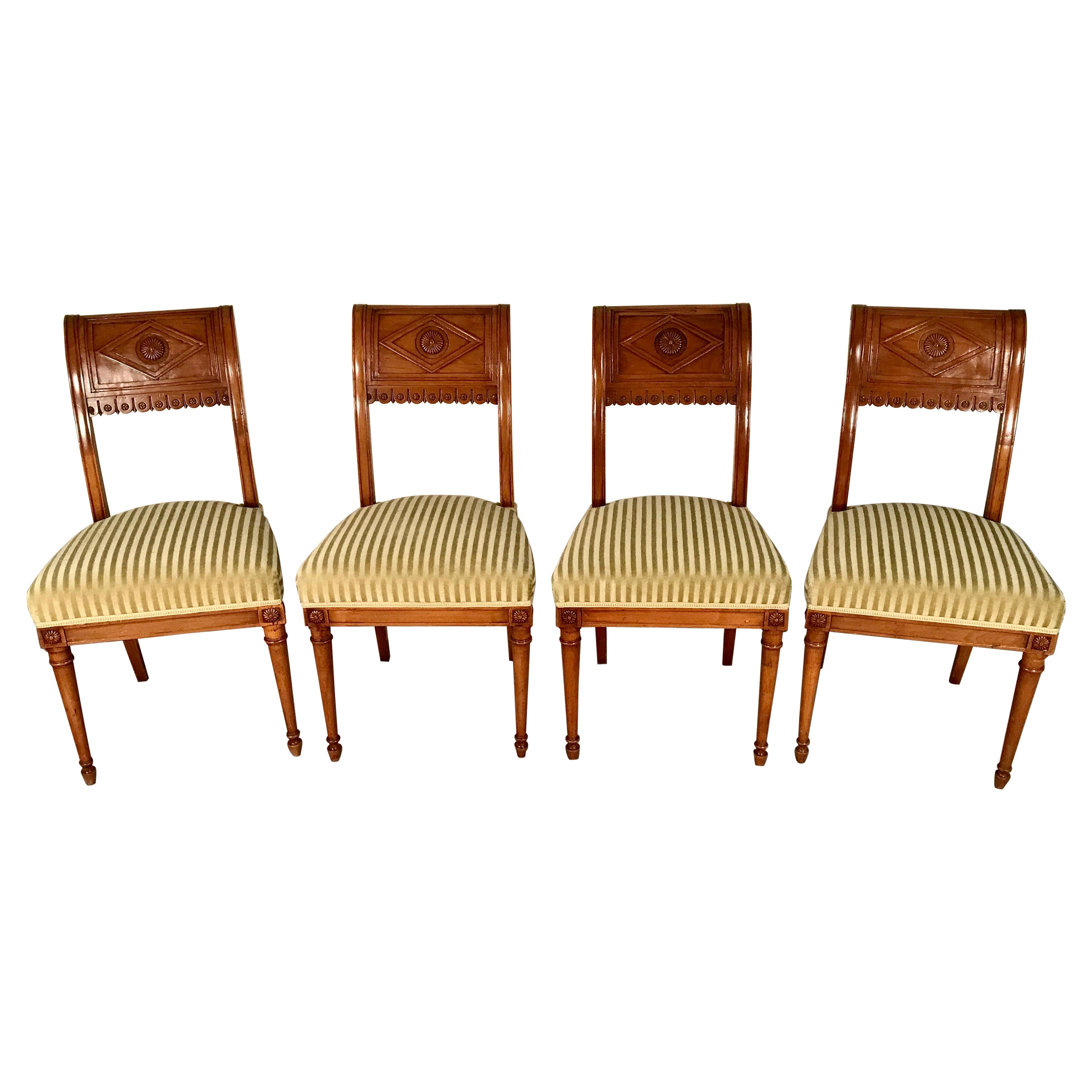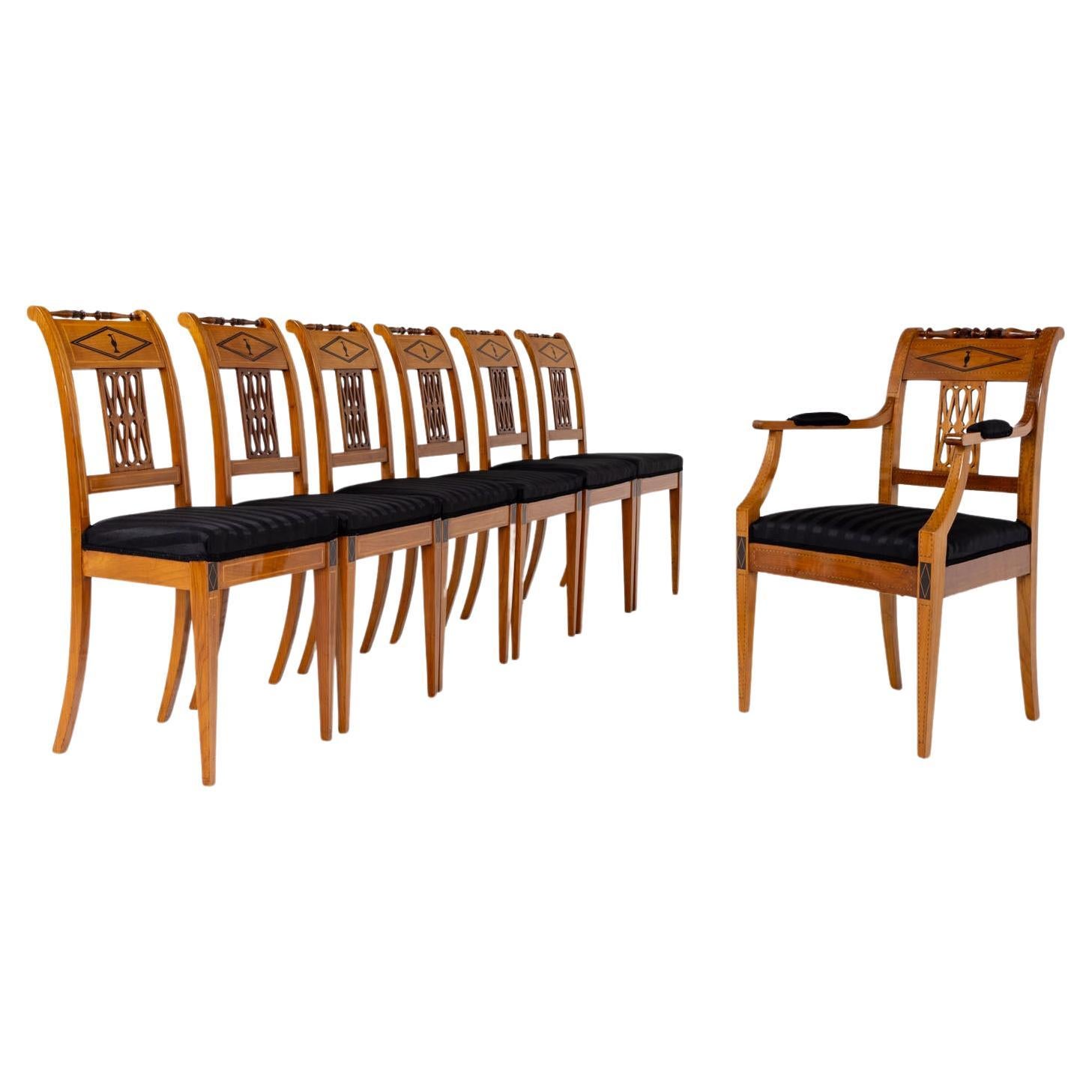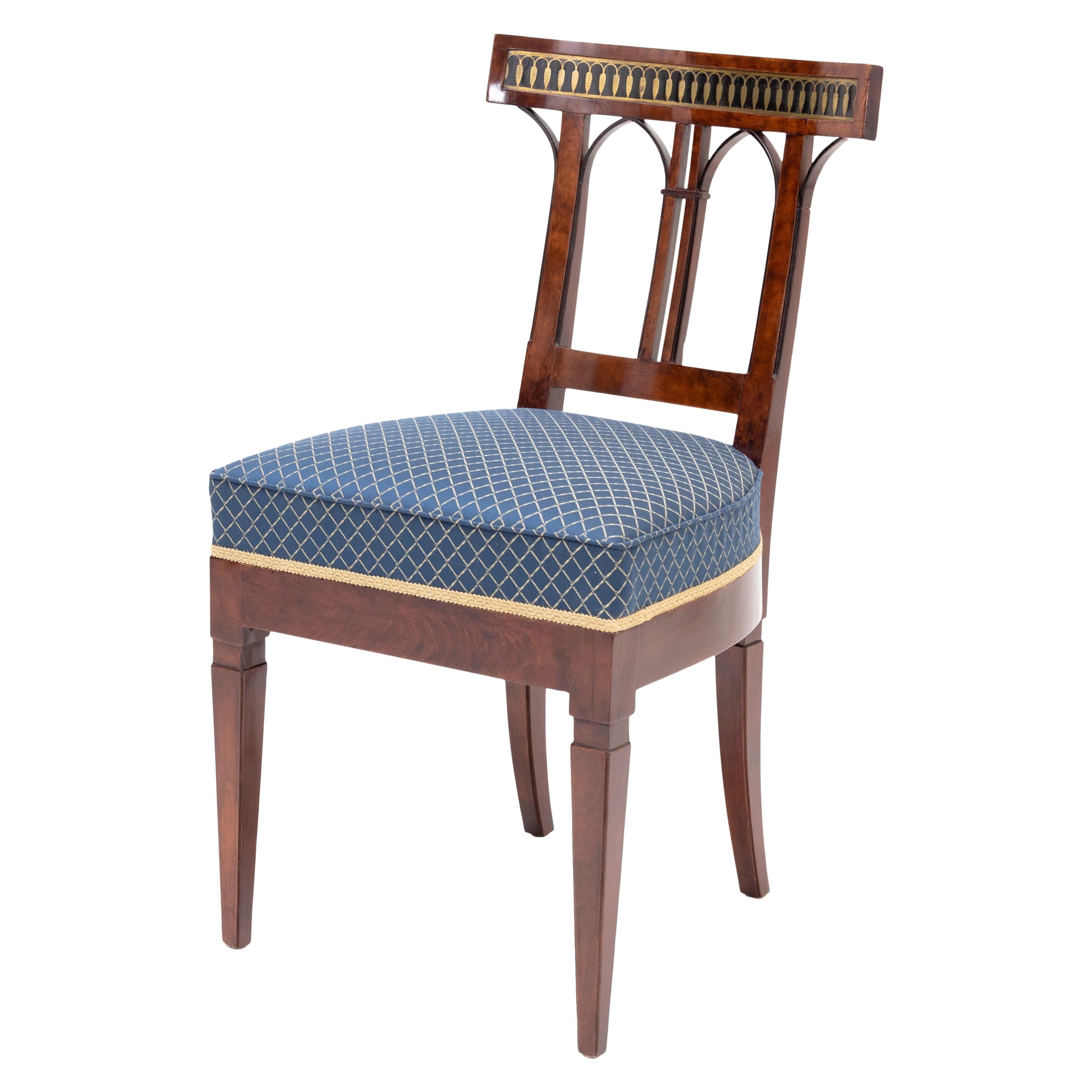Items Similar to Seven Early 19th Century Neoclassical Italian Chairs, Milan circa 1820
Video Loading
Want more images or videos?
Request additional images or videos from the seller
1 of 21
Seven Early 19th Century Neoclassical Italian Chairs, Milan circa 1820
About the Item
Group of seven chairs
Milan, first quarter of the 19th century
Carved walnut wood, lacquered in gray green and cream and partially gilded
They measure:
height 36.61 in (18.11 in to the seat) x 19.29 in x 19.68
(height 93 cm – 46 cm to the seat - 49 cm x 50 cm)
Each one weighs circa kg 10.00 (circa 22,04 lb)
State of conservation: some signs of use and some touch-up work performed on the lacquer. The green fabric is modern.
This is one of the seat models most in vogue in Milan at the beginning of the 19th century. It represents a simplified version of the models that evolved in the wake of the work of Giocondo Albertolli (1742-1839), who was considered the "restorer of good taste", that is, the one who brought back classic tastes. In fact, this revival saw Milan as one of the main venues for the birth of the new neoclassical esthetic among the late eighteenth and early nineteenth century. His teachings spread thanks to his numerous treatises and led to the birth of a fervent artistic current in Milan, in particular.
The chairs in question are well suited to this style: the curved back rests naturally on the rear legs, describing a semicircle; the fitting with the seat is turned. The simplicity of the hind legs, saber-shaped, contrasts with the shape of the front legs. These branch off from the seat through a quadrangular capital, narrow into a constriction centered around a ring, and then develop into a truncated cone. This tapers sharply downwards, is grooved and ends in a turned olive shape.
The chairs are soberly decorated with a gray green and cream lacquer, framing the seat and backrest, and are embellished with a slightly raised gilt profile. Other golden highlights mark the line and the carvings of the legs.
It is precisely the refined simplicity of the structure and the ornamentation which suggest an even earlier dating, perhaps around the turn of the two centuries.
Works of this type are found especially in Lombardy; see some refined models kept in the Museum of Applied Arts of the Castello Sforzesco in Milan (Enrico Colle, Museo d’Arti Applicate, mobili e intagli lignei, Milano 1996, p. 294 n. 495).
- Dimensions:Height: 36.62 in (93 cm)Width: 19.69 in (50 cm)Depth: 19.3 in (49 cm)Seat Height: 18.12 in (46 cm)
- Sold As:Set of 7
- Style:Neoclassical (Of the Period)
- Materials and Techniques:Walnut,Lacquered
- Place of Origin:
- Period:
- Date of Manufacture:circa 1820
- Condition:Reupholstered. Refinished. Minor fading. Some signs of use and some touch-up work performed on the lacquer. The green fabric is modern.
- Seller Location:Milano, IT
- Reference Number:1stDibs: LU4352217321572
About the Seller
4.3
Vetted Seller
These experienced sellers undergo a comprehensive evaluation by our team of in-house experts.
Established in 1860
1stDibs seller since 2018
Typical response time: 4 hours
Associations
International Confederation of Art and Antique Dealers' Associations
- ShippingRetrieving quote...Ships From: Milano, Italy
- Return PolicyA return for this item may be initiated within 14 days of delivery.
More From This SellerView All
- Six Mid-18th Century Italian Chairs, Venice, circa 1750Located in Milano, ITSix carved walnut chairs Venice, mid-18th century Height 35.03 in (18.70 in to the seat) x 19.09 in x 18.30 in (89 cm - 47.5 cm to the seat - x 48.5 cm x 46.5 cm) lb 80 (kg 36) Stat...Category
Antique 1750s Italian Rococo Dining Room Chairs
MaterialsWalnut
- Italian Carved Walnut Chairs with Leather Covers, Milan, circa 1750Located in Milano, ITFour carved walnut chairs with leather covers Milan, circa 1750 They measure: 39.37” high, 18.30” to the seat, 21.65” deep x 19.29” (100 cm high, 46.5 cm to the seat, 55 cm deep x 49 cm) State of conservation: - the leather covers are not original; - some signs of use, especially on leather covers; - the rocailles at the height of the backrests have lost part of the carved elements. The four walnut chairs have a mixtilinear structure adorned with rocaille relief carvings; the legs are shaped and end with a curl. The backs and seats are padded and covered with impressed leather with figures and cartouche decorations from later production. Around the mid-eighteenth century in Milan it was very popular to cover seats with impressed leather. Mutton or cowhide was used which, suitably tanned, was then worked with heated irons (hot decoration) or with carved wooden molds (cold decoration). These were impressed on the leather until obtaining a darker brown color. Our group of chairs...Category
Antique 1750s Italian Rococo Chairs
MaterialsWalnut, Leather
- 19th Century Italian Sterling Silver Madonna, circa 1830Located in Milano, ITEmbossed and engraved silver plaque La Madonna del lago (The Madonna of the Lake) Probably Milan, post 1824 Brass frame It measures 16.14 in x 13.85 in (41 x 35.2 cm) and it weighs 10.357 pounds (4.698 g): silver 1.31 pounds (598 g) + brass 9.03 pounds (4.100 g) State of conservation: some abrasions on the bottom. The frame is old, but not original. The plaque is made up of a sheet of embossed and engraved silver, and held in a solid brass frame. It depicts the “Madonna del lago” – “Madonna of the Lake” - (the Madonna with Child and San Giovannino) by Marco d'Oggiono (Oggiono, 1474 circa - Milan, 1524 circa), while changing only the background landscape. Almost certainly the subject reproduced in the plaque was taken from a famous engraving by Giuseppe Longhi (Monza, 1766 - Milan, 1831), one of the greatest engravers of his era. The silver is unmarked, probably because originally the Madonna was due to be exposed in a church: sometimes precious metals destined for worship and liturgical use would be exempted from payment and were, therefore, not marked. It is very likely that the plaque was made in Milan because in this city in 1824 the engraving by Giuseppe Longhi was made and printed. In addition, in Milan, the alleged lost painting by Leonardo da Vinci in his Milanese period (1482-1500) would be produced; this is the painting from which Marco d'Oggiono took his version. The painting Marco d?Oggiono was one of Leonardo da Vinci's most brilliant students and collaborators (D. Sedini, Marco d’Oggiono, tradizione e rinnovamento in Lombardia tra Quattrocento e Cinquecento, Roma 1989, pp. 151-153, n. 56; p. 225, n. 124, with previous bibliography). His style reflects in every way that of the Tuscan Maestro, so much so that he was the one who executed some copies of da Vinci's paintings. The execution of the “Madonna del Lago” probably draws inspiration from a lost painting by the Maestro, created while he was living in Milan (1482-1500). There are many similarities with other works by Leonardo such as the “Vergine delle rocce” or the “Vergine con il Bambino e San Giovannino, Sant’Anna e l’Agnello”. The painting, from which the drawing and then the famous engraving were taken, is found today at the M&G Museum of Bob Jones University in Greenville, South Carolina, where it came to rest after the sale of the Harrington Collection in London in 1917. The work appears in the inventories of the collection of Napoleon and Joséphine Bonaparte at the castle of Malmaison, before 1809. The Malmaison building was born and developed in the 17th and 18th centuries. In the 18th century it belonged to Jacques-Jean Le Coulteux du Molay, a wealthy banker. Later, during the Directory, Joséphine Bonaparte de Beauharnais bought it on April 21st, 1799, but settled at the castle definitively only after her husband separated from her in 1809. She remained there until 1814, the year of her death. When Joséphine died, the estate passed to her son Eugène de Beauharnais, who moved to Munich with his whole family in 1815, bringing with him the collection of paintings he inherited from his mother. Eugène died in 1824 and his wife Augusta of Bavaria (von Bayern), unable to keep it, in 1828 sold the Malmaison to the Swedish banker Jonas-Philip Hagerman. It is likely that in this period Augusta also sold part of the paintings inherited from her husband, including the “Madonna del Lago”. This painting then came into the possession of Leicester Stanhope, fifth Earl of Harrington (1784 - 1862) and then was passed down to his descendants. In 1917, at the death of Charles, eighth Earl of Harrington, his brother Dudley inherited the title and properties and he put up a part of his collections for sale. Among these, precisely, the painting by Marco d'Oggiono was to be found. On the occasion of that auction the painting was presented as a work by Cesare da Sesto, by virtue of a handwritten note by the Countess of Harrington on the back of the table. However, already in 1857, the German critic Gustav Waagen had identified Marco d'Oggiono as the author of the painting, then exhibited in the dining room of Harrington House in London (Treasures of Art in Great Britain, in 4 volumes, London, 1854 and 1857). The engraving Giuseppe Longhi was one of the most renowned engravers in Italy between the end of the 18th century and the first quarter of the 19th century. In 1824 Giuseppe Longhi, based on a design by Paolo Caronni, made a famous engraving of the painting of Marco d?Oggiono. The activity of Longhi was then at the peak of his notoriety, enough to earn him very substantial commissions; it is not risky to suppose that some of his successful engravings were also reproduced using other means: in our case in silver. (A. Crespi, a cura di, Giuseppe Longhi 1766–1831 e Raffaello Morghen...Category
Antique 1820s Italian Neoclassical Sterling Silver
MaterialsSterling Silver, Brass
- Large Italian Neoclassic Sterling Silver Coffee Pot, Milan, Circa 1830Located in Milano, ITEmbossed and engraved silver coffee pot Antonio Garavaglia Milan, Circa 1830 It measures 16.92 in (43 cm) in height and weighs 3.35 lb (1.520 gr) State of conservation: very good The large silver coffee pot has a round mouthpiece with a marked everted rim on which a pagoda lid rests; this is surmounted by a cock-shaped knob with a border decorated with small pods...Category
Antique 1820s Italian Neoclassical Sterling Silver
MaterialsSterling Silver
- Ancient Italian Neoclassic Sterling Silver Coffee Pot, Milan, circa 1850Located in Milano, ITEmbossed and engraved sterling silver coffee pot Tommaso Panizza (1805-1868) Milan, circa half of the 19th century It measures 13.97 in (cm 35.5) in height x 8.66 in (22 cm) x 4.7...Category
Antique 1840s Italian Neoclassical Sterling Silver
MaterialsSterling Silver
- Late 19th Century Italian Wood Mannequin, circa 1880Located in Milano, ITAtelier mannequin graven and carved stone pine wood Italy, late 19th century Measures: H 102 cm x 25 cm x 14 cm H 40.15 in x 9.84 in x 5.51 in Weight: circa kg 4 State of conse...Category
Antique 1880s Italian Other Figurative Sculptures
MaterialsWood
You May Also Like
- Early 19th Century Biedermeier Chairs, Set of Eight, Cherrywood, Circa 1820Located in Greven, DEEight identical antique Biedermeier chairs in cherry wood West Germany / France Cherry tree Biedermeier around 1820 Dimensions: H x W x...Category
Antique Early 19th Century German Biedermeier Dining Room Chairs
MaterialsCherry
- Set of 4 Early 19th Century English Regency Mahogany Dining Chairs, circa 1820Located in San Francisco, CAA set of four mahogany Regency style dining chairs, consisting of one armchair and three side chairs with upholstered seats. Recently upholstered. Q...Category
Antique Early 19th Century English Regency Dining Room Chairs
MaterialsMahogany
- Set of Four Neoclassical Chairs, Switzerland 19th CenturyLocated in Belmont, MASet of four Neoclassical Chairs, Switzerland 19th century. These unique chairs are made of cherry wood. The slightly bent backrests are decorated with hand-carved decor. At the uppe...Category
Antique 1840s Swiss Neoclassical Chairs
MaterialsCherry
- Set of seven Neoclassical Dining Room Chairs, early 19th CenturyLocated in Greding, DESet of six dining chairs and one armchair on high, elegant square tapered legs with thread inlays. The rear legs are slightly flared and, together with the rounded backrests, give th...Category
Antique Early 19th Century German Neoclassical Chairs
MaterialsCherry
- 19th Century Set of antique Biedermeier Chairs Cherrywood, 1820Located in Berlin, DEBeautiful set of Biedermeier chairs, circa 1820. Solid cheerywood. Slightly arched backrest with straight top and middle bridge. upholstered ...Category
Antique 18th Century German Biedermeier Chairs
MaterialsCherry
- Neoclassical Chair, Germany, Early 19th CenturyLocated in Greding, DENeoclassical chair on square pointed legs with straight frame and trapezoidal upholstered seat and openwork backrest with stylised pointed arches and brass inlays in the form of arca...Category
Antique Early 19th Century German Neoclassical Chairs
MaterialsWood
Recently Viewed
View AllMore Ways To Browse
Antique Italian Chairs
Antique Italian Chair
Italian Antique Chairs Italian Chairs
Italian Antique Chairs
Italian Backrest Chair
Curved Italian Chair
Italian Chair 19th
Italian Chairs 19th Century Chairs
19th Century Italian Chair
Early Italian Chairs
Neoclassic Chair
Antique Chair Other
Antique Chairs Other
Antique Two Seater Chair
Antique Two Seat Chair
Circa 1819
Antique Green Chairs
Green Antique Chairs





